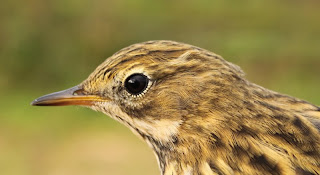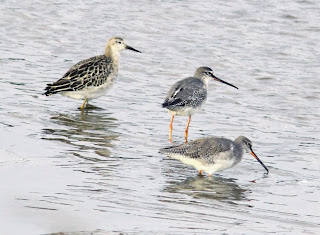Will and I met at Our Rawcliffe for our first ringing session since September 8th. The intervening period had seen poor weather synopses with periods of rain and wind, the twin enemies that frustrated our eagerness to continue the good results we obtained through the summer and early autumn. It was a hesitant start at 0630 under threatening rain clouds, but both the weather and our mood improved enough to say that by 1100 when we packed up, we had enjoyed a brilliant morning full of birds.
In total we caught 51 birds of 8 species, 48 new birds, 2 recaptures and 1 bird previously ringed elsewhere, a “control” in ringer’s terminology.
New birds: 21 Chaffinch, 18 Meadow Pipit, 4 Long-tailed Tit, 1 Goldfinch, 1 Chiffchaff, 1 Robin, 1 Lesser Whitethroat and 1 Dunnock. We recaptured a Chiffchaff and a Dunnock from previous visits, and the control bird was a Long-tailed Tit; Ring number 6O9704 anyone?





Capturing a number of Meadow Pipits for the first time since last autumn allowed us to “get our eye in” again with separating adult and juvenile autumn Meadow Pipits. In general adults have all tertials, greater coverts and median coverts of the same age with the pattern of the greater and median coverts having a rather evenly broad olive-toned buff tip with only a slight “tooth” and well defined and indented buff margin to the greater coverts. In contrast, first year birds have a pronounced “tooth” on the median coverts and rather pale buff tips to these, and the outer webs of the greater coverts are edged paler and more whitish. So in general the wing of an adult appears darker and more evenly olive toned whereas a juvenile wing looks more variable by virtue of most of its buff and pale tipped coverts or the contrast between its juvenile coverts and any newer, replaced “adult” type coverts. What we also have to bear in mind when ageing Meadow Pipits is that early broods may have been out of the nest from mid or late May, four months ago, whereas birds from later in the season may have plumage characteristics dating from several weeks ago only.


After a series of mornings in August and early September whereby we reported little or no visible migration, in contrast the difference today was quite striking, perhaps helped by the very light south easterly wind that blew from 0630 until about 10am when it swung round to the predicted north westerly direction. There were noticeable, mainly south or south westerly movements of 200+ Meadow Pipit, 250 Swallow, 20 House Martin and 50+ Skylarks which arrived from a true north or even north easterly direction
Other birds seen this morning included 190 Pink-footed Goose over in various directions, Sparrowhawk, Kestrel, several Goldfinch, 1 Jay and 1 Grey Wagtail. As on the last few occasions, the movement of Chaffinch was not especially marked or obvious, but as we caught 21 we can only assume this was small percentage of those moving through the site for the four hours we remained there.














.jpg)






































.jpg)












